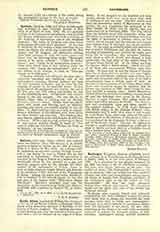

Battista, GIOVANNI GIUDA GIONA (his original name was JEHUDA JONA BEN-ISAAC), b. of Jewish parents at Safed in Galilee, on the 28th of October, 1588; d. at Rome, May 26, 1668. As a Jewish rabbi he undertook an extensive journey through Europe, and it was during his stay in Poland that he was converted to Catholicism. After his conversion he was sent by the King of Poland on a mission to Constantinople, where he was arrested as a spy, and narrowly escaped with his life through the intervention of the ambassador of Venice. Later he went to Italy, where he taught Hebrew and Aramaic at the Academy of Pisa and then at the Propaganda at Rome. Among his pupils was Giulio Bartolocci, who is indebted to his learned master for the idea and plan of his famous work “Bibliotheca Magna Rabbinica”. Battista’s principal work was the translation of the Gospels from Latin into Hebrew, published, with a preface by Clement IX, at Rome, 1668.
F. X. E. ALBERT

